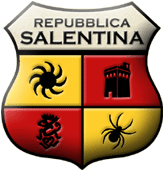It isn't a country, it's a "res publica"!
 Though the name may let us think the contrary, “Repubblica Salentina” is not a new State, but rather a movement and its name reminds “res publica”; by these words Latin people named “something that belonged to everyone”, “something for everybody’s sake”. Though the name may let us think the contrary, “Repubblica Salentina” is not a new State, but rather a movement and its name reminds “res publica”; by these words Latin people named “something that belonged to everyone”, “something for everybody’s sake”.
This new form of Republic, born inside a school (the Technical Institute “Costa” of Lecce, indeed) promotes the cultural, artistical, economical and touristic development of Salento.
The movement was born two years ago but, after such a short period of time, the activities of Repubblica Salentina are so much famous and appreciated all over Italy that the work of these young people is considered one of the most advanced and original strategies in the field of territorial marketing.
What do the icons represent?
The Sun stands for Nature and all its elements.
The Tower stands for the History of the Land.
The Neolithic Icon (found out in the "Grotta dei Cervi") stands for the Land and the People.
The Spider ("tarantola") stands for Culture and Traditions.
| |